Table of Contents[Hide][Show]
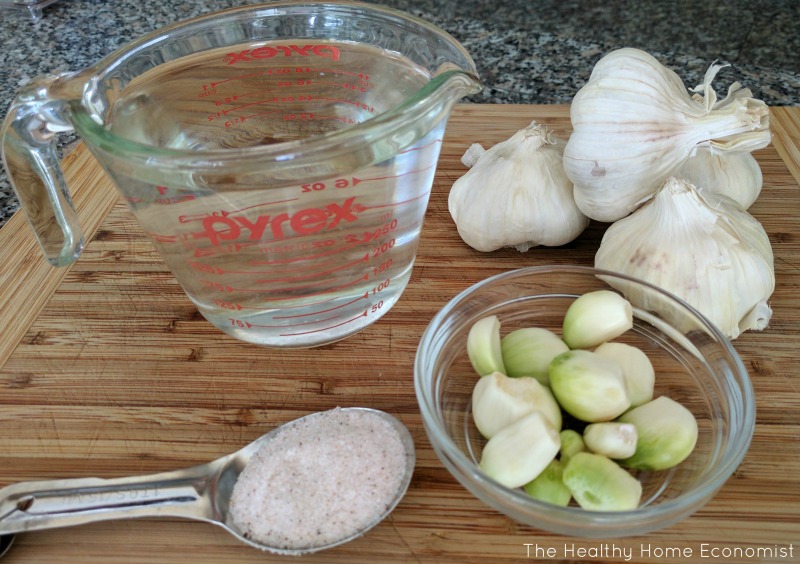
If you peruse the most popular pickled garlic recipes on the internet, nearly every single one contains vinegar and/or sugar. Even more problematic, the instructions frequently suggest using white vinegar and refined white sugar.
Both of these ingredients are almost always GMO frankenfoods at least in North America! The vinegar is derived from glyphosate laced GMO corn and usually the white sugar from Roundup Ready GMO sugarbeets. If you thought the white or brown sugar at the store was pure cane sugar, guess again. Unless the packaging specifically says “cane sugar”, it’s all or partially derived from gut destroying GMO beets.
Even worse (if that’s possible), the recipes suggest cooking the garlic!
Unfortunately, this isn’t the optimal way to go about it – certainly not if you wish to enhance the natural anti-viral, anti-fungal, and antibiotic power of garlic.
Raw garlic is a highly potent weapon for staying healthy. It is effective at fighting, not just pathogenic bacteria. It fights all harmful microbes including viruses and fungi. For this reason alone, it far outperforms synthetic antibiotics for non-life-threatening infections and illnesses when used properly. What’s more, garlic doesn’t harm your beneficial intestinal microbes and unbalance the gut for months or even years afterward as meds do.
Why in the world would you want to destroy all those unmatched benefits by cooking the cloves and then pickling in vinegar and sugar?
The key is to ferment the garlic.
~Fermented vegetables are always pickled, but not all pickled vegetables are fermented~
This article on pickled vs fermented foods contains more information so that you don’t ever get fooled into thinking a pickled food at the store has probiotic value. Check the ingredients. If there’s vinegar and/or sugar listed, don’t buy it.
Benefits of Pickled Garlic
Perhaps the greatest benefits of pickling garlic instead of eating it without fermenting are these:
- The inherent hotness of eating a raw clove is greatly reduced and/or virtually eliminated.
- The icky potential for reeking of garlic on your breath and in your sweat goes bye-bye.
Hence, fermenting garlic eliminates the negative aspects of eating raw garlic without reducing or eliminating any of the natural benefits. In addition, the probiotic and enzymatic value of garlic is enhanced by fermentation.
There just isn’t any reason whatsoever to pickle cooked garlic in vinegar. Unless of course you are a food manufacturer and mass production and supermarket shelf life are of primary concern.
Using Fermented Garlic Therapeutically
I recently gave a talk at my daughter’s school on the immune system. The teacher hosting the class told me that he knows a farmer who eats a raw clove of garlic every day to help ward off illness.
Dr. Natasha Campbell-McBride MD, author of the bestselling book about the GAPS Diet, would concur. In fact, she recommends eating an entire head of garlic per day (one clove every few hours during waking hours) until the illness or infection subsides.
The great thing about having a jar of fermented garlic on hand is that you can easily grab a clove or two whenever you need it. This is reminiscent of having a jar of the Master Tonic in the pantry during cold/flu season.
I like to suck on a clove as a natural remedy for sore throat. While sucking on a raw clove (let alone chewing it) is too hot for many people, sucking on a pickled clove is easy to do. In fact, the flavor is similar to roasted garlic and quite tasty. Thus, fermented garlic cloves are a great option for children over age 3.
As mentioned before, those who are sensitive to raw garlic will likely find pickled garlic to be no problem. The fermentation process conveniently eliminates some of the stinky aspects of the body and breath afterward.
Pickling garlic that is properly fermented is also a frugal alternative to using garlic or allicin supplements. On the positive side, buffered garlic in pill form is very convenient for traveling, so don’t completely discount this as an option on occasion.
Pickled Garlic Recipe
Cori H. of Billings, Montana suggested the wonderfully easy recipe for pickled garlic below. Cori is also the local Weston Price (WAPF) Chapter Leader if you happen to live in that area and would like more local food ideas. You can check out her blog by clicking here.
Green Garlic?
Please note that sometimes pickling garlic will turn slightly greenish or bluish. It is perfectly safe to eat. This is in contrast to white potatoes that are green under the skin, which should be tossed!
Garlic naturally contains beneficial sulfur compounds that can react with the copper in water to form copper sulfate. This is a blue or blue-green compound. The amount of copper needed for this reaction is very small and is frequently found in normal water supplies even when the water is filtered. If you have reverse-osmosis water, you probably won’t experience this while pickling garlic as RO water removes most of the minerals.
The bottom line is as long as the cloves are nestled safely within the brine water, a slight color change isn’t a problem. One of the wonders of fermentation is that each batch can turn out a bit differently!
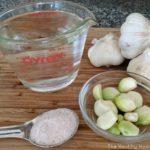
Pickled Garlic
Easy recipe for pickled garlic that will boost the flavor of dishes and can also be used medicinally as a natural antibiotic and anti-viral.
Ingredients
- 5-6 heads of garlic preferably organic
- 1 pint filtered water
- 1 Tbl sea salt
Instructions
-
Separate all the cloves from each head of garlic.
-
Carefully remove the papery skin from each clove.
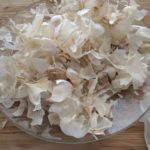
-
Place all the cloves in a mason jar and fill with filtered water mixed with sea salt.
-
Place a fermentation weight on top. This will keep the cloves at the bottom of the jar when the water is added. This is a simpler and more frugal option than expensive Pickl-It jars and anaerobic lids.
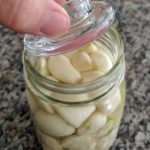
-
Make sure at least 1 inch is left for air at the top of the jar.
-
Close the lid tightly and place in a cool pantry or cabinet for one month. Best to label the lid so you remember when the fermentation began.

-
After one month, transfer to the refrigerator. Consume the pickled cloves as needed to flavor dishes and as one of the best natural antibiotics.
Recipe Notes
Do not use large elephant garlic, as it does not have the same therapeutic value.
You may wish to check on the pickling garlic every week or so during the month long fermentation. If the water level has decreased, add more brinewater as needed (1 Tbl sea salt per pint of filtered water).
**Open the jar over the sink as the pressure can build up substantially from the fermentation.
If you get sick during the time the garlic is pickling, feel free to dive into those cloves early. They will probably still be a little hot, but they will be highly therapeutic nonetheless.
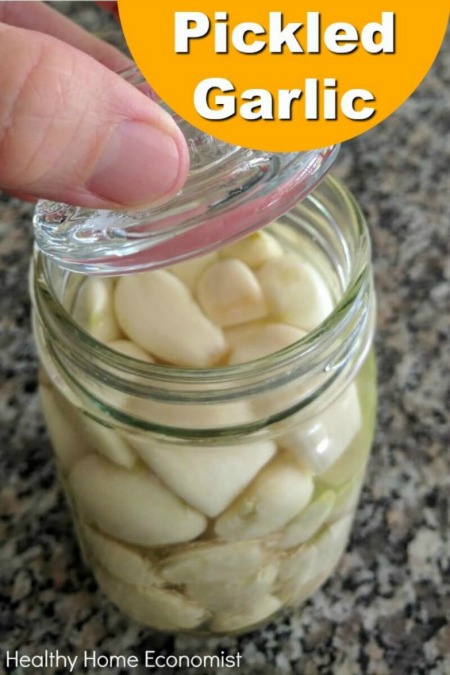








Making this now. You don’t have to burp the jar? Thank you!
I never do.
Thanks for sharing. I didn’t have a fermentation weight so used a few cabbage leaves on top instead. Worked like a charm.
Awesome! What a creative idea!!
I just opened mine and it is very strong smelling.To the point where it makes me sick to smell.
No mold. Water was cloudy.
Thoughts?
I am hoping its fine–I put 50 cloves in jars!!!
Sounds fine to me! Fermentation will reduce the smell but it won’t be gone completely and with 50 cloves … it will still be potent for sure.
for storage, do you just put them in a mason jar no water? Just by themselves?
This is a fermentedrecipe I’d like to try. The organic garlic that I’ve seen in the store usually comes in netting with three heads. I guess it would be best to start with a pint rather than quart jar. How long would this normally last in the fridge?
Hello, thank you for the information and the recipe. My only question, is can I replace the sea salt with Himalayan salt?
Himalayan salt IS a type of sea salt 🙂
I have limited refrigeration and about 100 bulbs of hardneck I harvested in late July. I have a cold room that is about 10c now (50F), I can get it close to 2c (36f), what his the highest temperature needed to slow down fermentation. I want to ferment now and store in cold room and use all winter. I can keep my room at that 0 c to +4 temp until April 1st up here. I’m in Prince Edward Island Canada.
Thanks
I finally got weights and made the recipe about 2 weeks ago. The jars are in my basement pantry but the smell is throughout the house. I checked them tonight and many cloves are turning green. I read down through the comments and saw that it’s from the copper in my water. Nothing was s aid about not eating it so I take it it’s ok to eat. There’s one that’s turning black. Is that ok? Should I leave it?, fish it out? Has it contaminated the whole jar? Dump it all? Also, on one jar in particular there’s what looks like rechrystalized salt on the outside of the jar. It’s quite foamy inside the jar. Please advise,,,,thank you! Oh, one more thing. If whey is used instead of salt does it lower the sodium content? Thanks
Green is fine, black is not. The rest of the jar is probably fine … you will have to wait and see if more go black and/or if mold occurs. Yes, whey lowers the sodium content.
I suggest a heavy duty air filter if you made that many jars and the smell is too much.
This is my first attempt to ferment garlic. I peeled 25 bulbs of garlic into a half gallon jar. As the ferment started, a few of the smaller cloves worked their way out of the brine. I had been given advice of using a ziploc of water under the helix to keep them in the brine. The bag lost water in the ferment pressure. Now I have a milk jug disc to keep the garlic in the brine. Please explain the smell or appearance that will tell me if this garlic is good or bad.
Wow, I have the same question you do…..I hope someone answers….
Hi Sarah…thank you for all that you do 🙂
Regarding picked garlic, how careful do I have to be?
. Should throw out cloves I find mold on or just cut the mold off; do I have to worry about mold spores contaminating the rest of the clove(s)?
. If I touch/cut a clove w/mold, do I have to steralize the knife/my hands?
. Is it ok to cut the tips of a clove to make it easier to peel it?
. Can a clove be crushed ‘just a bit’ to help release the skin?
. If the cloves are BIG, is it ok to cut them ‘to size’?
Thanks for any help,
Ellen